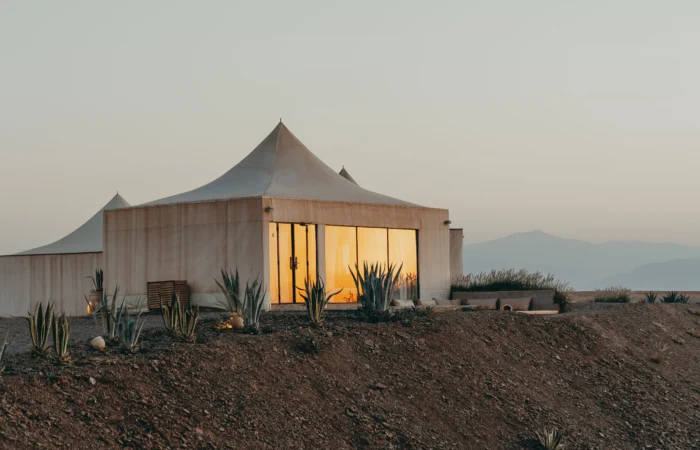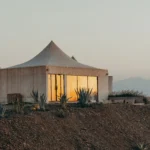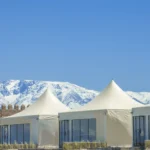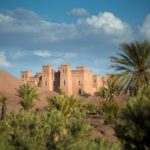Besides Summer heat, Marrakech, a vibrant city known for its rich history and culture, experiences intense heat during the summer months. For centuries, the people of Marrakech have developed ingenious ways to cope with the scorching temperatures, employing a mix of architectural innovations, social customs, and natural resources. Understanding these traditional methods offers insight into the resilience and creativity of Moroccan society.
Table of Contents
The Climate of Marrakech 
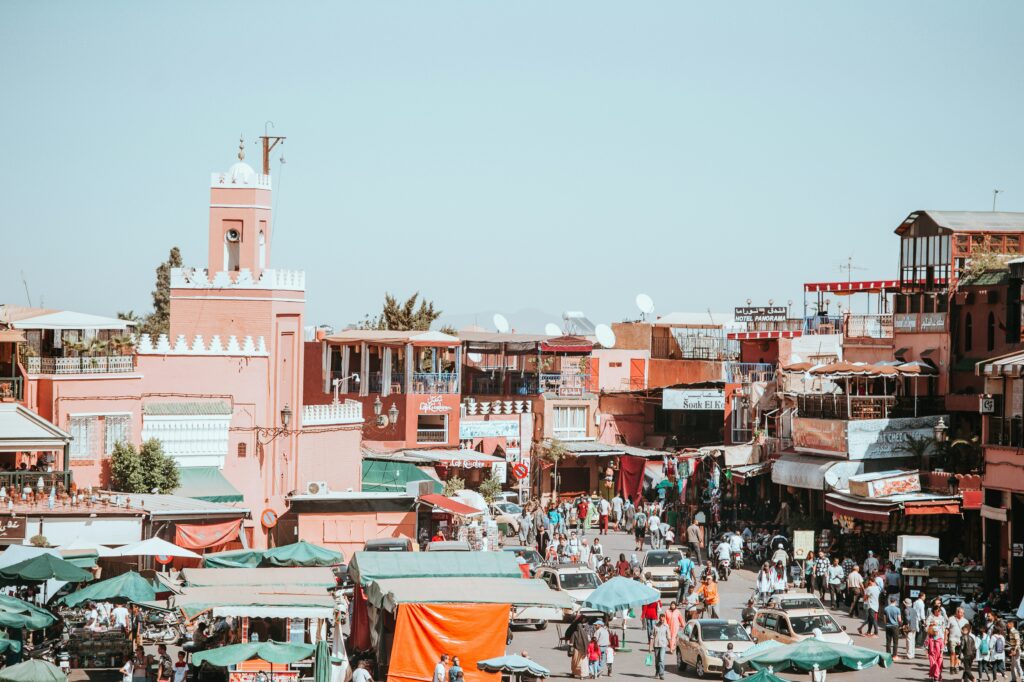
Situated near the foothills of the Atlas Mountains, Marrakech has a desert climate characterized by hot, dry summers and mild winters. Temperatures can soar above 40°C (104°F) during peak summer months, making effective cooling strategies essential for comfort and survival.
Traditional Moroccan Architecture 
Cooling Techniques in Architecture

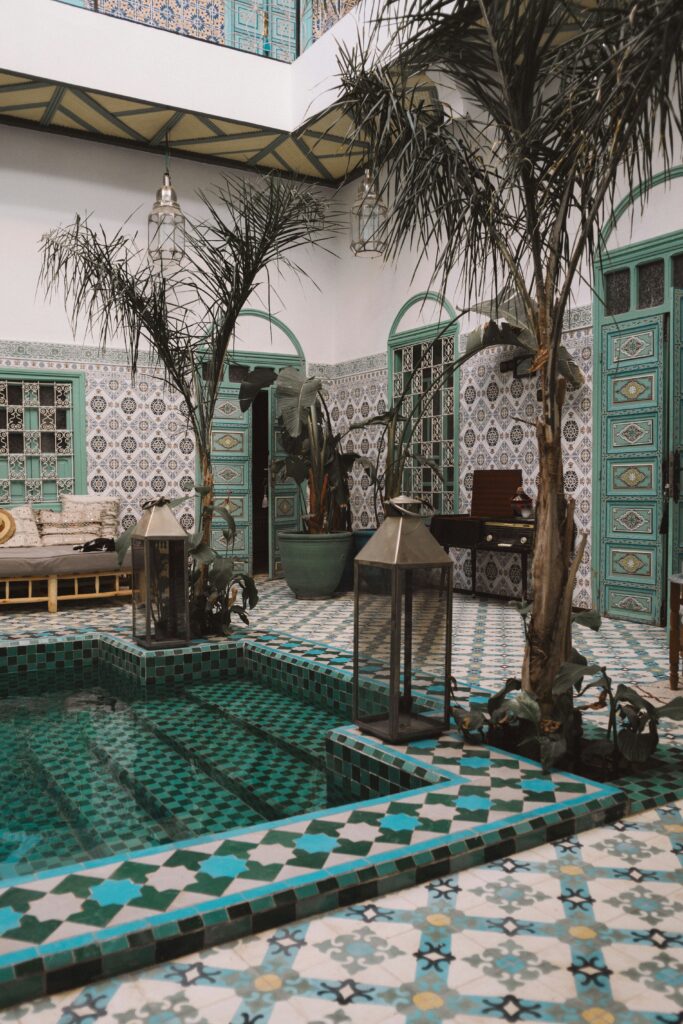
One of the most striking features of traditional Moroccan architecture is its design focused on mitigating heat. Riads, the traditional Moroccan houses, are built with thick walls made of clay or stone to keep the interiors cool. The central courtyard, often adorned with a fountain or a garden, serves as a natural air conditioner, allowing cooler air to circulate throughout the house.
Riads and Courtyards Riads are traditional Moroccan homes with a distinctive architectural feature: an interior courtyard. This central courtyard typically includes a garden or a fountain, which helps cool the air as it circulates through the building. The thick, earthen walls of riads provide natural insulation, keeping the heat out during the day and releasing warmth during the cooler nights.
The Role of Water 
Water plays a crucial role in traditional Moroccan cooling techniques to deal with summer heat. Fountains and pools are not just decorative elements but practical solutions for cooling the air. The sound and sight of water also provide a psychological sense of coolness. Ingenious irrigation systems, known as khettaras, were used to transport water from the mountains to the city, ensuring a constant supply for both drinking and cooling purposes.
Khettaras and Fountains Khettaras are ancient underground irrigation channels that bring water from distant sources to urban areas. These channels were essential for maintaining gardens, public baths, and fountains. The presence of water bodies in courtyards and public spaces significantly lowers the ambient temperature through evaporation, making the surroundings more comfortable.
The Importance of Shade 
Creating Shaded Spaces
Shade is another critical component in combating the heat. Traditional Moroccan gardens, such as the famous Majorelle Garden, are designed with dense foliage and shaded walkways to provide respite from the sun. Trees, pergolas, and covered patios create shaded areas where people can relax during the hottest parts of the day.
Gardens and Greenery Gardens in Marrakech, often featuring date palms, citrus trees, and bougainvillea, are carefully planned to create extensive shaded areas. The lush vegetation not only provides shade but also cools the air through transpiration. Gardens are a haven during the hot summer months, offering a cool retreat amidst the greenery.
Clothing and Fabrics 
The traditional clothing of Marrakech’s residents is specifically designed to cope with the heat. Loose, flowing garments made from light, breathable fabrics help to keep the body cool. The djellaba, a long, hooded robe, and the kaftan, a type of tunic, are both popular choices that provide comfort while protecting from the sun.
Traditional Garments Loose-fitting clothes allow air to circulate around the body, which helps in evaporating sweat and keeping the skin cool. The use of natural fabrics like cotton and linen ensures that the clothes are breathable, which is crucial for staying comfortable in the heat. The hooded djellaba also offers protection from the sun, reducing direct exposure to UV rays.
Social and Cultural Practices 
Social customs also play a role in dealing with the heat. Taking a siesta, or afternoon nap, is a common practice, allowing people to rest during the peak heat and stay active later in the cooler evening hours. Tea culture is another significant aspect, with Moroccan mint tea being a popular beverage that is both refreshing and cooling.
Siestas and Social Life During the hottest part of the day, businesses often close, and people retreat to their homes for a siesta. This practice not only provides rest but also helps avoid the most intense heat. Social activities and gatherings are typically scheduled for the evening, when temperatures drop, and the city comes alive with vibrant nightlife.
The Role of Food and Drink 
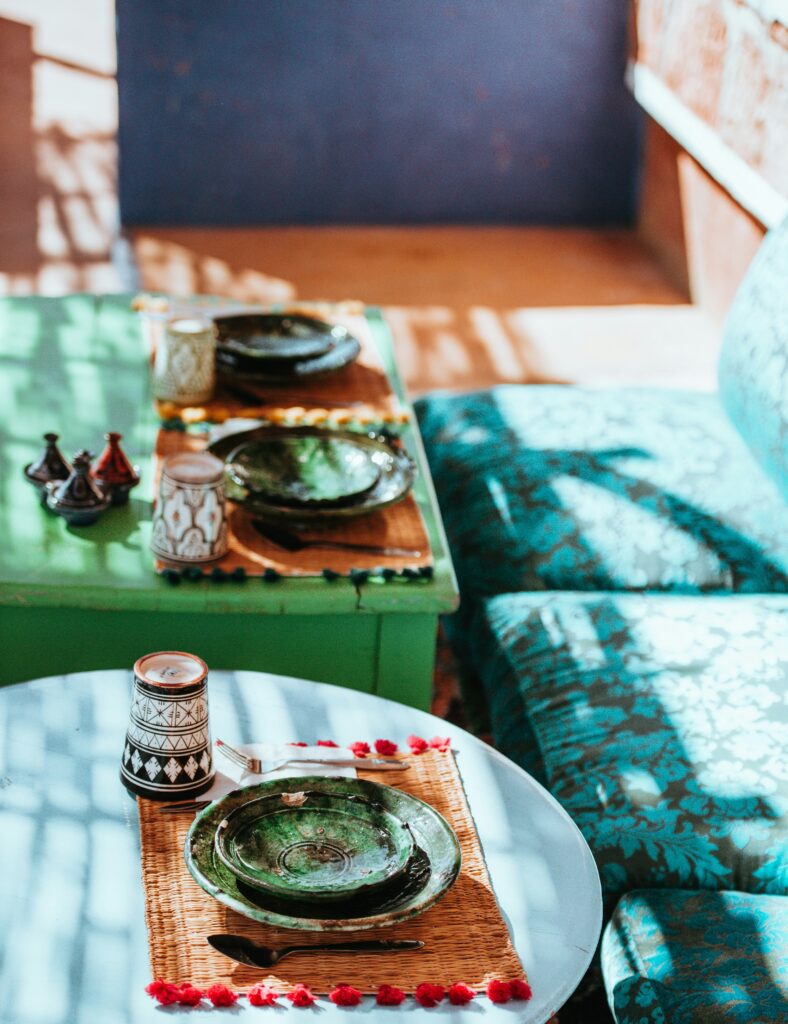
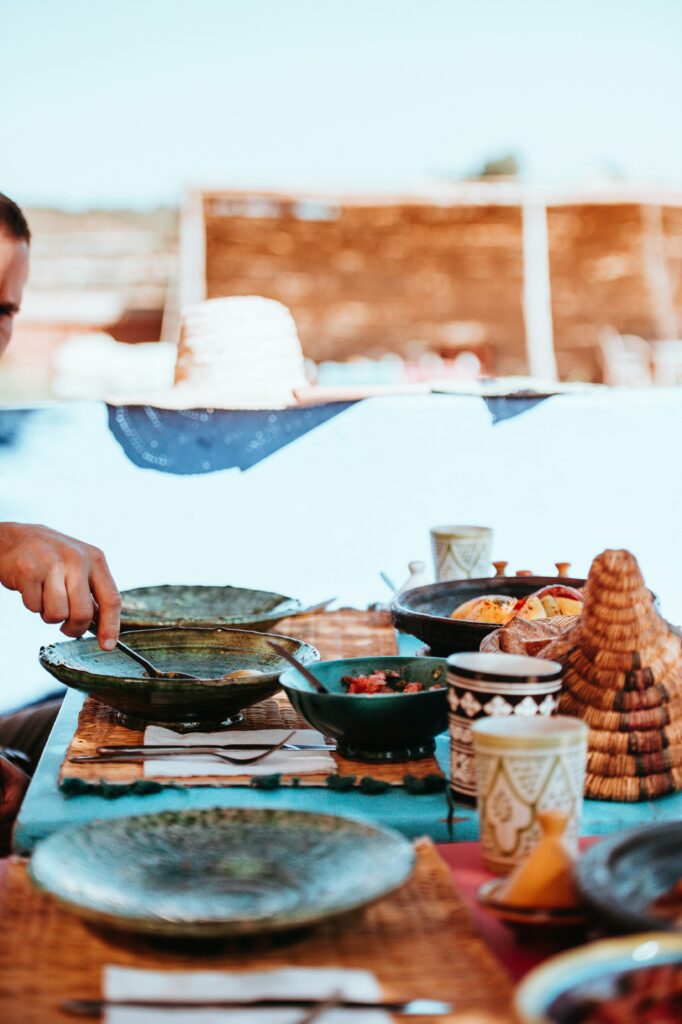
Dietary habits help in coping with the heat. Cooling foods like fresh fruits, vegetables, and salads are staples during the summer. Refreshing drinks, such as the aforementioned mint tea and fresh fruit juices, are consumed to stay hydrated and cool.
Cooling Foods and Drinks Foods with high water content, such as cucumbers, melons, and tomatoes, are common in summer meals. These foods help maintain hydration levels and provide a cooling effect. Moroccan mint tea, served hot, paradoxically induces sweating, which cools the body through evaporation. Additionally, fresh fruit juices and smoothies are popular choices to beat the heat.
Historical Public Spaces 
Souks and Medinas
Public spaces in Marrakech, such as the bustling souks and medinas, are designed to be cool and shaded. Narrow streets and covered markets protect shoppers from the sun, while communal areas often feature shaded seating and water features.
Design of Public Spaces The narrow alleys of the medinas are intentionally designed to maximize shade throughout the day. The labyrinthine layout not only provides shade but also creates a cooler microclimate. Souks are often covered with reed mats or cloth canopies, further reducing exposure to direct sunlight and making shopping more comfortable.
Innovations in Ventilation 
Ventilation has always been a crucial aspect of Moroccan architecture. Wind towers, known as malqaf, capture cool breezes and direct them into the building, while hot air escapes through upper vents. This natural ventilation system effectively cools interiors without the need for modern air conditioning.
Wind Towers and Natural Ventilation Wind towers are an ancient form of air conditioning used in Moroccan and Middle Eastern architecture. These towers capture wind from above and funnel it into living spaces, creating a cooling breeze. The hot air inside the building rises and exits through upper openings, maintaining a continuous flow of air.
Migration Patterns 
Seasonal Migration
Historically, some residents would migrate to cooler areas during the summer. The Atlas Mountains, with their higher altitudes and cooler temperatures, provided a seasonal refuge. Wealthier families often had summer residences in these areas to escape the heat of Marrakech.
Seasonal Escapes Families would move to the mountains or coastal areas to escape the summer heat. This seasonal migration was a common practice among those who could afford it, allowing them to avoid the hottest months in the city and enjoy cooler, more pleasant climates.
Modern Adaptations 
While traditional methods are still valued, modern technology has also been adopted to combat the heat. Air conditioning has become more common in homes and businesses, and modern architectural designs often incorporate both traditional and contemporary cooling techniques.
Blending Old and New Modern buildings in Marrakech often combine traditional design elements, like thick walls and courtyards, with contemporary cooling technologies. This blend ensures that the interiors remain cool while preserving the aesthetic and cultural heritage of Moroccan architecture.
The White Camel Agafay 

For those seeking luxury and comfort amidst the heat, The White Camel Agafay offers a perfect retreat. Located in the Agafay Desert near Marrakech, this luxurious camp provides modern amenities while embracing the traditional cooling techniques of Moroccan architecture. Guests can enjoy activities like camel rides and stargazing, combining adventure with relaxation in a serene desert environment.
Luxurious Escape The White Camel Agafay offers a unique blend of luxury and tradition. The camp’s design incorporates natural cooling methods, such as shaded tents and water features, alongside modern comforts like air conditioning and gourmet dining. This makes it an ideal destination for experiencing the beauty and tranquility of the desert without compromising on comfort.
Conclusion
The people of Marrakech have historically utilized a blend of architectural ingenuity, cultural practices, and natural resources to cope with the intense summer heat. These methods reflect a deep understanding of the environment and a commitment to comfort and well-being, even in the harshest conditions.
FAQs
How did traditional Moroccan architecture help in cooling homes? Traditional Moroccan homes, especially riads, are designed with thick walls and central courtyards that help in keeping the interiors cool. The use of water features and shaded areas further aids in reducing the temperature inside the house.
What are some traditional Moroccan clothing items designed for summer? Traditional Moroccan clothing like the djellaba and kaftan are made from light, breathable fabrics. These loose-fitting garments allow air circulation and protect from the sun, making them ideal for the hot summer months.
How important is water in Moroccan cooling techniques? Water is crucial in Moroccan cooling techniques. Fountains, pools, and irrigation systems not only provide a cooling effect through evaporation but also create a soothing environment. The presence of water in courtyards and public spaces helps in significantly lowering ambient temperatures.
What social practices help Moroccans cope with the heat? Taking a siesta during the hottest part of the day and enjoying social activities in the cooler evening hours are common practices. Additionally, the consumption of refreshing drinks like mint tea and fresh juices helps in staying hydrated and cool.
How did Marrakech residents manage heat before modern air conditioning? Before modern air conditioning, Marrakech residents relied on architectural designs that maximized natural ventilation, shaded public spaces, traditional clothing, and seasonal migration to cooler areas. These methods collectively helped in managing the intense summer heat.
What makes The White Camel Agafay a unique destination? The White Camel Agafay combines traditional Moroccan cooling techniques with modern luxury amenities. Located in the serene Agafay Desert, it offers a unique blend of adventure and relaxation, making it an ideal retreat from the summer heat of Marrakech.


